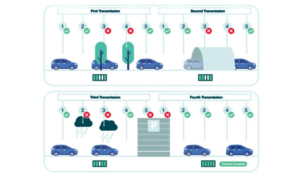As the 2024 film awards season kicks off, Dr Henrik Axelsson, CEO of KenCast, recognises the unsung technology assuring movies arrive at the cinema. This article was originally published by TVB Europe at https://www.tvbeurope.com/media-delivery/why-fec-beats-planes-trains-and-automobiles-for-film-delivery
As the film industry prepares itself for another awards season, in-between the glamour of red-carpet premieres and gold-plated statuettes is an equally critical process upon which the success of a film is dependent.
The distribution of movie files, whether Hollywood blockbusters or arthouse independents, must be done with efficiency, assuredness and security in mind – especially as the industry competes with streaming sites and the threat of leaks risks damaging reputations and revenues before official releases.
Everything everywhere all at once
The movie industry needs distribution networks that can be trusted to guarantee delivery of files everywhere and at any time – and all in one piece.
The industry has by and large left the physical delivery of film reels to cinemas in favour of digital distribution. Movies have also adopted more elaborate digital production techniques, making files a lot larger. Although the average film file size is about 250 gigabytes, because of CGI and 4K resolution, films exceeding one terabyte are not uncommon. The way these files are distributed needs to keep up with the pace of growing complexity and demands of large files.
A space odyssey
Some cinemas still receive physical hard drives containing digital files but digital distribution networks, using either satellite or terrestrial or a hybrid of both, are more efficient and remove the risk of theft or damage of physical shipments. Terrestrial networks, thanks to the rapid development of fibre technology, offer high-bandwidth for delivering movies. Nonetheless, content delivery networks (CDNs) can be costly to scale beyond local or regional distributions or for independent films.
Another option is to use satellite, which can achieve very high bandwidth and data rates. Built-in redundancy makes such networks dependable, delivering constant connectivity. Deployment expenditure is often cheaper than terrestrial and operating expenditure is typically lower too. Perhaps most importantly, it is highly scalable – which, for studios and cinemas, is ideal for distributing global film launches in run-up to awards seasons.
Multicasting is the most common method for distributing these types of files over satellite. With a single transmission, the movie can concurrently be received at thousands of geographically dispersed sites. It’s not naturally error-proof, however.
Broadcasted data files are affected by delay, degradation and deletion. The result is an incomplete or damaged file – which is no use to a cinema catering to packed houses of fans eager for the next Marvel instalment. Those larger files we talked about make the job harder, too.
‘Spraying and praying’ – resending a file over and over until all content is successfully received – is inefficient and can rack up costs. What distribution networks need instead is forward error correction, or ‘FEC’ – a mathematical concept utilising algorithms to correct errors during transmission. Best understood as working like a Sudoku puzzle where if a user receives enough numbers, they can work out what the missing ones are, FEC’s algorithms can solve all the missing pieces, ensuring completion of the entire file or stream.
This is much more efficient for large Hollywood-scale distributions. Encryption adds a layer of security by combing channel coding technology to both correct transmission errors while encrypting the received information. Only sending FEC packets, as opposed to sending source data, also makes it harder to reconstruct what is being sent (as does transmitting once instead of multiple times). Not all FEC is created equal, however.
May the FEC be with you
Only the highest quality FEC will ensure the most reliable delivery of files the first time they are sent – despite errors that may have occurred during transmissions.
The better the algorithm, the higher the efficiency of error correction, the greater the reliability of delivery, the faster the speed for a complete transmission, and the larger the cost savings on retransmissions. It is important for movie distribution networks to have the right level of FEC. Advanced FEC operates at the application level (AL). This is where file sizes are largest, the time of transmission is longest and the need for error correction is greatest. AL-FEC is aware and unrestricted, checking for errors and repairing data across different levels. This removes the need for retransmissions.
As the movie industry, from the major studios to smaller production companies, gears up for another awards season it’s important that efficiency is on the bill as it looks to ensure content is distributed far and wide.


